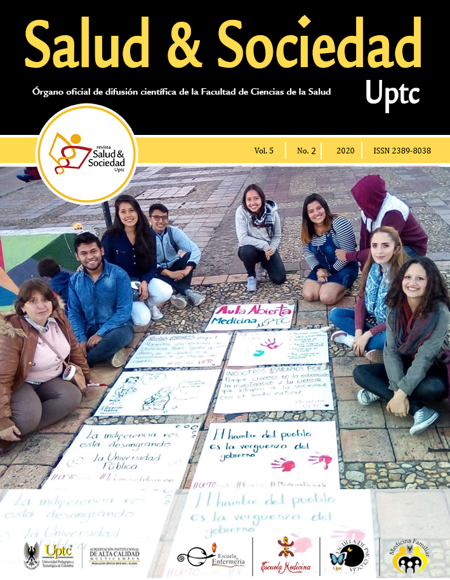The genogram and the ecomap as assessment tools in family medicine: a community experience

Abstract
Introduction: In Family Medicine, the use of genograms and ecomaps is useful for clinical, family and community practice, in the field of primary health care; however, its role has only been evaluated in the clinical setting. Objectives: To characterize the families participating in the community project from the genograms and ecomaps made by the resident doctors in a neighborhood of the city of Tunja, (Boyacá). Materials and methods: A descriptive cross-sectional study was carried out, compiling information from the genograms and ecomaps applied to the participating families. Results: 49 families were described mainly nuclear, small and bi-generational, with strong internal parental, conjugal and fraternal relationships, with solid external relationships with religion, work and the exterior family. Significant variability was found in the completion of the instruments by the residents. Conclusions: Genograms and ecomaps are instruments that have been used in the clinical context, and are relevant for knowing and analyzing health conditions in the community and family environment, since they can identify weaknesses and strengths, to facilitate the intervention in internal relationships and outside the family.
References
- Ministerio de salud y protección social. Directrices de obligatorio cumplimiento para la operación de la Ruta de Promoción y Mantenimiento de la Salud. [Online].; Febrero de 2017 [cited 2020 Octubre 13. Available from: www.minsalud.gov.co.
- Suárez Cuba M. El Genograma: Herramienta para el estudio y abordaje de la familia. Rev Med La Paz. 2010; 16(1): p. 53-57. http://www.scielo.org.bo/pdf/rmcmlp/v16n1/v16n1_a10.pdf
- Leoncio É, Pereira de Souza S, Martinz Machado J. Degradation of parental bonding and violence against children: The use of Family genogram in the pediatric clinic. Rev Paul Pediatr. 2017 Mayo 11; 35(2): p. 185-190. https://www.ncbi.nlm.nih.gov/pmc/articles/PMC5496717/
- Juré E, Iguenane J, Toudonou A, Azondekon A, Gagnayre R. The usefulness of a genogramas a tool in therapeutic patient education: an exploratory study of parents of children living with HIV / AIDS in Benin. Santé Publiqué. 2010; 22(1): p. 11-22. https://www.cairn.info/revue-sante-publique-2010-1-page-11.htm#
- Leonidas C, Santos M. Family relations in eating disorders: the Genogram as instrument of assessment. Ciência & Saúde Coletiva. 2015; 20(5): p. 1435-1447. https://www.scielo.br/scielo.php?pid=S1413-81232015000501435&script=sci_arttext
- Sitnik-Warchulska K, Izydorczyk B. Family Patterns and Suicidal and Violent Behavior among Adolescent Girls - Genogram Analysis. Int. J. Environ. Res. Public Health. 2018 Sept 20; 15: p. 1-16. https://pubmed.ncbi.nlm.nih.gov/30241331/
- Samson T, Peleg R, Biderman A, Press Y. Developing a Comprehensive Geriatric Genogram Assessment Tool. IMAJ. 2019; 21: p. 796-800. https://pubmed.ncbi.nlm.nih.gov/31814342/
- Browning S, Hull R. Treating Multidimensional Presenting Problems with a Mutually Integrative Approach Using the Genogram. Family Process. 2019;: p. 1-13. https://onlinelibrary.wiley.com/doi/abs/10.1111/famp.12470
- Libbon R, Triana J, Heru A, Berman E. Family Skills for the Resident Toolbox: the 10-min Genogram, Ecomap, and Prescribing Homework. Academic Psychiatry. 2019 March 23;: p. 1-5. https://pubmed.ncbi.nlm.nih.gov/30905028/
- Suarez Cuba M. Aplicación del ecomapa como herramienta para identificar recursos extrafamiliares. Rev Med La Paz. 2015; 21(1): p. 72-74. http://www.scielo.org.bo/scielo.php?script=sci_arttext&pid=S1726-89582015000100010
- Paris de Souza Í, Bellato R, Santos de Araújo L, Barros de Almeida K. Genogram and Ecomap as tools for understanding Family Care in Chronic Illness of the Young. Texto Contexto Enferm. 2016; 25(4): p. 1-10. https://www.scielo.br/scielo.php?script=sci_arttext&pid=S0104-07072016000400301
- Van Weel C. The extraordinary diagnostic sensitivity of family physicians. Family Practice. 2020;: p. 1-3. https://pubmed.ncbi.nlm.nih.gov/32382738/
- Rodríguez Escobar M. Aportes de la medicina familiar a la APS en Iberoamérica: revisión hermenéutica 1971-2016. Editorial Universidad El Bosque. 2019.
- Gómez Clavelina F, Irigoyen Coria A, Ponce Rosas E, Terán-Trillo M, Fernández Ortega M, Yáñez Puig E. Análisis comparativo de seis recomendaciones internacionales para el diseño de genogramas en medicina familiar. Arch Med Fam. 1999; 1(1): p. 13-20.
- De la Revilla A. Conceptos e instrumentos de la atención familiar. In AL. DlR. El genograma: cómo realizarlo. Barcelona: Doyma; 1994.
- Sánchez Rengifo M. Evaluación y trazado de la estructura de la familiar. In Evaluación del conflicto conyugar: una guía para principiantes.: In Valle Ud; 2001. p. 23-55.
- de Souza Pereira A, Martins Telxeira G, Belcorso Bressan C, Gue Martini J. O genograma e o ecomapa no cuidado de enfermagem em saúde da família. Rev Bras enferm. 2009; 62(3): p. 407-416. https://www.scielo.br/scielo.php?pid=S003471672009000300012&script=sci_abstract&tlng =pt
- Turabian J. Family Genogram in General Medicine: A Soft Technology that can be Strong. An Update. Res Med Eng Sci. 2017; 3(1): p. 186-191.
- Alba L. Familia y práctica médica. Univ. Méd. 2012; 53(2): p. 166-185. https://crimsonpublishers.com/rmes/pdf/RMES.000551.pdf
- DANE. Cómo vivimos. [Online]. [cited 2020 10 12. Available from: https://www.dane.gov.co/index.php/estadisticas-por-tema/demografia-y-poblacion/censonacional-de-poblacion-y-vivenda-2018/como-vivimos.
- Agudelo E, Ayala M, Ríos M, Gómez D, López L, Taborda D. Caracterizacíon de las familias en las localidades de la Florida, Samaria, Galán y San Nicolás en Pereira, Colombia. Investigaciones Andina. 2011; 12(22): p. 212-227. http://www.scielo.org.co/scielo.php?script=sci_abstract&pid=S0124- 81462011000100009&lng=en&nrm=iso&tlng=es
- Navarro-García A, Ponce-Rosas R, Monroy-Caballero C, Trujillo-Benavides E, IrigoyenCoria A, Gómez-Clavelina F. Estrategias para la elaboración de genogramas por residentes de medicina familiar. Archivo de Medicina Familiar. 2004; 6(3): p. 78-83. https://www.medigraphic.com/cgi-bin/new/resumen.cgi?IDARTICULO=1382